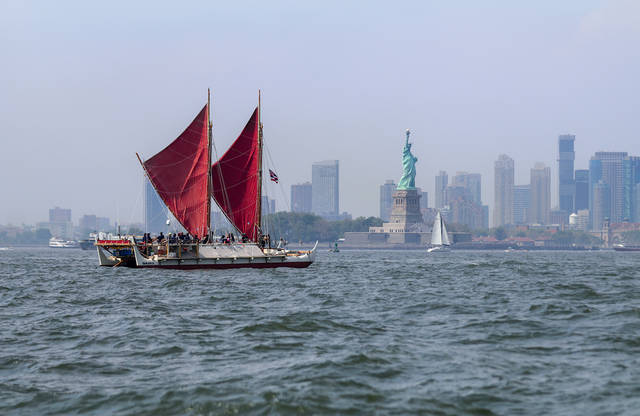Leg 5: East Coast segment honors multiple Native American tribes

COURTESY ‘OIWI TV
Nearly 40 years to the day that the Hokule‘a crew sighted land in French Polynesia on its maiden voyage, the vessel sailed into New York in June 2016, passing the Statue of Liberty in the distance.

COURTESY ‘OIWI TV
Musician and community advocate Laulani Teale greets master navigator Bruce Blankenfeld after a welcome ceremony in New York.

COURTESY ‘OIWI TV
Native American tribes from across the Northeast gathered at the Mashpee Wampanoag Pow Wow near Cape Cod, Mass. Hokule‘a crew members participated in the gathering as they sailed up the East Coast. A young girl showing off her regalia dances with her friends and family.



In March 2016, when the Hokule‘a first landed in South Florida, the canoe didn’t head to bustling, populous, cosmopolitan Miami.
Instead, its first stop on the East Coast would be serene Everglades National Park, where crews were welcomed by the area’s indigenous Miccosukee and Seminole tribes and they learned about local conservation efforts from park service officials.
The landing would set the tone for most of the Hokule‘a’s trip along the East Coast — a nine-month expedition in which crews made a deliberate effort to honor the local Native American tribes wherever they went and highlighted efforts to protect watersheds and the environment.
March 2016 to December 2016
DISTANCE
5,523 miles
—
MORE HOKULE’A
>> View the special section: The Homecoming
“I was surprised that we would go to a place called Piscataway and they would say, ‘This is the first time in 418 years anybody asked for permission to come in,’” Nainoa Thompson recounted of the Native American leaders who received them outside Washington, D.C., in May 2016.
Earlier, while still in Florida, the Hokule‘a visited the Kennedy Space Center at Cape Canaveral with the family of Charles Lacy Veach, the late astronaut and Punahou School graduate who helped inspire the Malama Voyage before dying of cancer in 1995.
Don't miss out on what's happening!
Stay in touch with breaking news, as it happens, conveniently in your email inbox. It's FREE!
The East Coast trip did feature pivotal and much-hyped stops in urban Washington and New York — a chance for the Polynesian Voyaging Society to raise national awareness of the Malama Honua voyage and its purpose.
While the Hokule‘a was docked on the Potomac River in Georgetown, for example, an NPR news crew broadcast a tour of the canoe on Facebook Live to thousands of online viewers. About 2,000 people greeted the canoe in the Big Apple for the United Nations’ annual World Oceans Day.
The canoe’s crews reunited with Ban Ki-moon, the U.N. secretary-general, after meeting him in Samoa two years earlier. Thompson delivered to Ban pledges to better protect marine resources from groups and local governments they met during the voyage.
The canoe also traveled through New England and Nova Scotia. An escort boat towed the engineless Polynesian sailing vessel through a series of narrow inland canals and 61 locks to reach Lake Ontario, the Saint Lawrence River and the Hudson River. From there it ventured back south down the Eastern Seaboard — and ended its stay on the continent in Miami.




